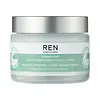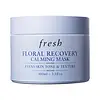What's inside
What's inside
 Key Ingredients
Key Ingredients

 Benefits
Benefits

 Concerns
Concerns

 Ingredients Side-by-side
Ingredients Side-by-side

Water
Skin ConditioningGlycerin
HumectantCetearyl Alcohol
EmollientCaprylyl Caprylate/Caprate
EmollientOlus Oil
EmollientLactobacillus Ferment
Skin ConditioningButyrospermum Parkii Butter
Skin ConditioningHelianthus Annuus Seed Wax
Skin ConditioningSimmondsia Chinensis Seed Oil
EmollientCetearyl Glucoside
EmulsifyingPropanediol
SolventAlgae Extract
EmollientCetyl Alcohol
EmollientLactobacillus
Skin ConditioningAlpha-Glucan Oligosaccharide
CleansingParfum
MaskingTocopheryl Acetate
AntioxidantCaprylic/Capric Triglyceride
MaskingPanthenol
Skin ConditioningCarbomer
Emulsion StabilisingVaccinium Vitis-Idaea Seed Oil
AntioxidantXanthan Gum
EmulsifyingArnica Montana Flower Extract
MaskingCamelina Sativa Seed Oil
Skin ConditioningCocos Nucifera Fruit Extract
EmollientTocopherol
AntioxidantMagnesium Carboxymethyl Beta-Glucan
Skin ConditioningMalachite Extract
AntioxidantAlbatrellus Ovinus Extract
Skin ConditioningLaminaria Ochroleuca Extract
Skin ConditioningGlucose
HumectantPhenoxyethanol
PreservativeHelianthus Annuus Seed Oil
EmollientCitric Acid
BufferingSodium Hydroxide
BufferingRosmarinus Officinalis Leaf Extract
AntimicrobialCitronellol
PerfumingGeraniol
PerfumingLimonene
PerfumingWater, Glycerin, Cetearyl Alcohol, Caprylyl Caprylate/Caprate, Olus Oil, Lactobacillus Ferment, Butyrospermum Parkii Butter, Helianthus Annuus Seed Wax, Simmondsia Chinensis Seed Oil, Cetearyl Glucoside, Propanediol, Algae Extract, Cetyl Alcohol, Lactobacillus, Alpha-Glucan Oligosaccharide, Parfum, Tocopheryl Acetate, Caprylic/Capric Triglyceride, Panthenol, Carbomer, Vaccinium Vitis-Idaea Seed Oil, Xanthan Gum, Arnica Montana Flower Extract, Camelina Sativa Seed Oil, Cocos Nucifera Fruit Extract, Tocopherol, Magnesium Carboxymethyl Beta-Glucan, Malachite Extract, Albatrellus Ovinus Extract, Laminaria Ochroleuca Extract, Glucose, Phenoxyethanol, Helianthus Annuus Seed Oil, Citric Acid, Sodium Hydroxide, Rosmarinus Officinalis Leaf Extract, Citronellol, Geraniol, Limonene
Water
Skin ConditioningGlycerin
HumectantSqualane
EmollientCamellia Oleifera Seed Oil
Skin ConditioningCetearyl Alcohol
EmollientPropanediol
Solvent1,2-Hexanediol
Skin ConditioningAscorbyl Glucoside
AntioxidantPassiflora Edulis Seed Oil
EmollientCentaurea Cyanus Flower Water
Skin ConditioningPrunus Cerasus Flower Extract
Skin ConditioningPaeonia Suffruticosa Root Extract
Skin ProtectingTocopheryl Acetate
AntioxidantTocopherol
AntioxidantHydrogenated Coco-Glycerides
EmollientCetearyl Glucoside
EmulsifyingCetyl Alcohol
EmollientStearyl Alcohol
EmollientSodium Stearoyl Glutamate
CleansingSodium Hydroxide
BufferingAcrylates/C10-30 Alkyl Acrylate Crosspolymer
Emulsion StabilisingPolyacrylate Crosspolymer-6
Emulsion StabilisingBetaine
HumectantButylene Glycol
HumectantParfum
MaskingSodium Hyaluronate
HumectantChlorphenesin
AntimicrobialSodium Benzoate
MaskingPotassium Sorbate
PreservativeWater, Glycerin, Squalane, Camellia Oleifera Seed Oil, Cetearyl Alcohol, Propanediol, 1,2-Hexanediol, Ascorbyl Glucoside, Passiflora Edulis Seed Oil, Centaurea Cyanus Flower Water, Prunus Cerasus Flower Extract, Paeonia Suffruticosa Root Extract, Tocopheryl Acetate, Tocopherol, Hydrogenated Coco-Glycerides, Cetearyl Glucoside, Cetyl Alcohol, Stearyl Alcohol, Sodium Stearoyl Glutamate, Sodium Hydroxide, Acrylates/C10-30 Alkyl Acrylate Crosspolymer, Polyacrylate Crosspolymer-6, Betaine, Butylene Glycol, Parfum, Sodium Hyaluronate, Chlorphenesin, Sodium Benzoate, Potassium Sorbate
 Reviews
Reviews

Ingredients Explained
These ingredients are found in both products.
Ingredients higher up in an ingredient list are typically present in a larger amount.
Cetearyl alcohol is a mixture of two fatty alcohols: cetyl alcohol and stearyl alcohol. It is mainly used as an emulsifier. Emulsifiers help prevent the separation of oils and products. Due to its composition, it can also be used to thicken a product or help create foam.
Cetearyl alcohol is an emollient. Emollients help soothe and hydrate the skin by trapping moisture.
Studies show Cetearyl alcohol is non-toxic and non-irritating. The FDA allows products labeled "alcohol-free" to have fatty alcohols.
This ingredient is usually derived from plant oils such as palm, vegetable, or coconut oils. There is debate on whether this ingredient will cause acne.
Due to the fatty acid base, this ingredient may not be Malassezia folliculitis safe.
Learn more about Cetearyl AlcoholCetearyl Glucoside is a surfactant and emulsifier. It can be produced from synthetic of natural sources of cetearyl alcohol and glucose.
Emulsifiers help prevent ingredients from separating, such as oils and waters. It can also be used to enhance the texture of products.
As a surfactant, Cetearyl Glucoside helps during the cleansing process. By gathering all the dirt and oils, it allows these molecules to be washed away easily.
Learn more about Cetearyl GlucosideCetyl Alcohol is a fatty alcohol. Fatty Alcohols are most often used as an emollient or to thicken a product.
Its main roles are:
Though it has "alcohol" in the name, it is not related to denatured alcohol or ethyl alcohol.
The FDA allows products labeled "alcohol-free" to have fatty alcohols.
Learn more about Cetyl AlcoholGlycerin is already naturally found in your skin. It helps moisturize and protect your skin.
A study from 2016 found glycerin to be more effective as a humectant than AHAs and hyaluronic acid.
As a humectant, it helps the skin stay hydrated by pulling moisture to your skin. The low molecular weight of glycerin allows it to pull moisture into the deeper layers of your skin.
Hydrated skin improves your skin barrier; Your skin barrier helps protect against irritants and bacteria.
Glycerin has also been found to have antimicrobial and antiviral properties. Due to these properties, glycerin is often used in wound and burn treatments.
In cosmetics, glycerin is usually derived from plants such as soybean or palm. However, it can also be sourced from animals, such as tallow or animal fat.
This ingredient is organic, colorless, odorless, and non-toxic.
Glycerin is the name for this ingredient in American English. British English uses Glycerol/Glycerine.
Learn more about GlycerinParfum is a catch-all term for an ingredient or more that is used to give a scent to products.
Also called "fragrance", this ingredient can be a blend of hundreds of chemicals or plant oils. This means every product with "fragrance" or "parfum" in the ingredients list is a different mixture.
For instance, Habanolide is a proprietary trade name for a specific aroma chemical. When used as a fragrance ingredient in cosmetics, most aroma chemicals fall under the broad labeling category of “FRAGRANCE” or “PARFUM” according to EU and US regulations.
The term 'parfum' or 'fragrance' is not regulated in many countries. In many cases, it is up to the brand to define this term.
For instance, many brands choose to label themselves as "fragrance-free" because they are not using synthetic fragrances. However, their products may still contain ingredients such as essential oils that are considered a fragrance by INCI standards.
One example is Calendula flower extract. Calendula is an essential oil that still imparts a scent or 'fragrance'.
Depending on the blend, the ingredients in the mixture can cause allergies and sensitivities on the skin. Some ingredients that are known EU allergens include linalool and citronellol.
Parfum can also be used to mask or cover an unpleasant scent.
The bottom line is: not all fragrances/parfum/ingredients are created equally. If you are worried about fragrances, we recommend taking a closer look at an ingredient. And of course, we always recommend speaking with a professional.
Learn more about ParfumPropanediol is an all-star ingredient. It softens, hydrates, and smooths the skin.
It’s often used to:
Propanediol is not likely to cause sensitivity and considered safe to use. It is derived from corn or petroleum with a clear color and no scent.
Learn more about PropanediolSodium Hydroxide is also known as lye or caustic soda. It is used to adjust the pH of products; many ingredients require a specific pH to be effective.
In small amounts, sodium hydroxide is considered safe to use. However, large amounts may cause chemical burns due to its high alkaline.
Your skin has a natural pH and acid mantle. This acid mantle helps prevent harmful bacteria from breaking through. The acid mantle also helps keep your skin hydrated.
"Alkaline" refers to a high pH level. A low pH level would be considered acidic.
Learn more about Sodium HydroxideTocopherol (also known as Vitamin E) is a common antioxidant used to help protect the skin from free-radicals and strengthen the skin barrier. It's also fat soluble - this means our skin is great at absorbing it.
Vitamin E also helps keep your natural skin lipids healthy. Your lipid skin barrier naturally consists of lipids, ceramides, and fatty acids. Vitamin E offers extra protection for your skin’s lipid barrier, keeping your skin healthy and nourished.
Another benefit is a bit of UV protection. Vitamin E helps reduce the damage caused by UVB rays. (It should not replace your sunscreen). Combining it with Vitamin C can decrease sunburned cells and hyperpigmentation after UV exposure.
You might have noticed Vitamin E + C often paired together. This is because it is great at stabilizing Vitamin C. Using the two together helps increase the effectiveness of both ingredients.
There are often claims that Vitamin E can reduce/prevent scarring, but these claims haven't been confirmed by scientific research.
Learn more about TocopherolTocopheryl Acetate is AKA Vitamin E. It is an antioxidant and protects your skin from free radicals. Free radicals damage the skin by breaking down collagen.
One study found using Tocopheryl Acetate with Vitamin C decreased the number of sunburned cells.
Tocopheryl Acetate is commonly found in both skincare and dietary supplements.
Learn more about Tocopheryl AcetateWater. It's the most common cosmetic ingredient of all. You'll usually see it at the top of ingredient lists, meaning that it makes up the largest part of the product.
So why is it so popular? Water most often acts as a solvent - this means that it helps dissolve other ingredients into the formulation.
You'll also recognize water as that liquid we all need to stay alive. If you see this, drink a glass of water. Stay hydrated!
Learn more about Water